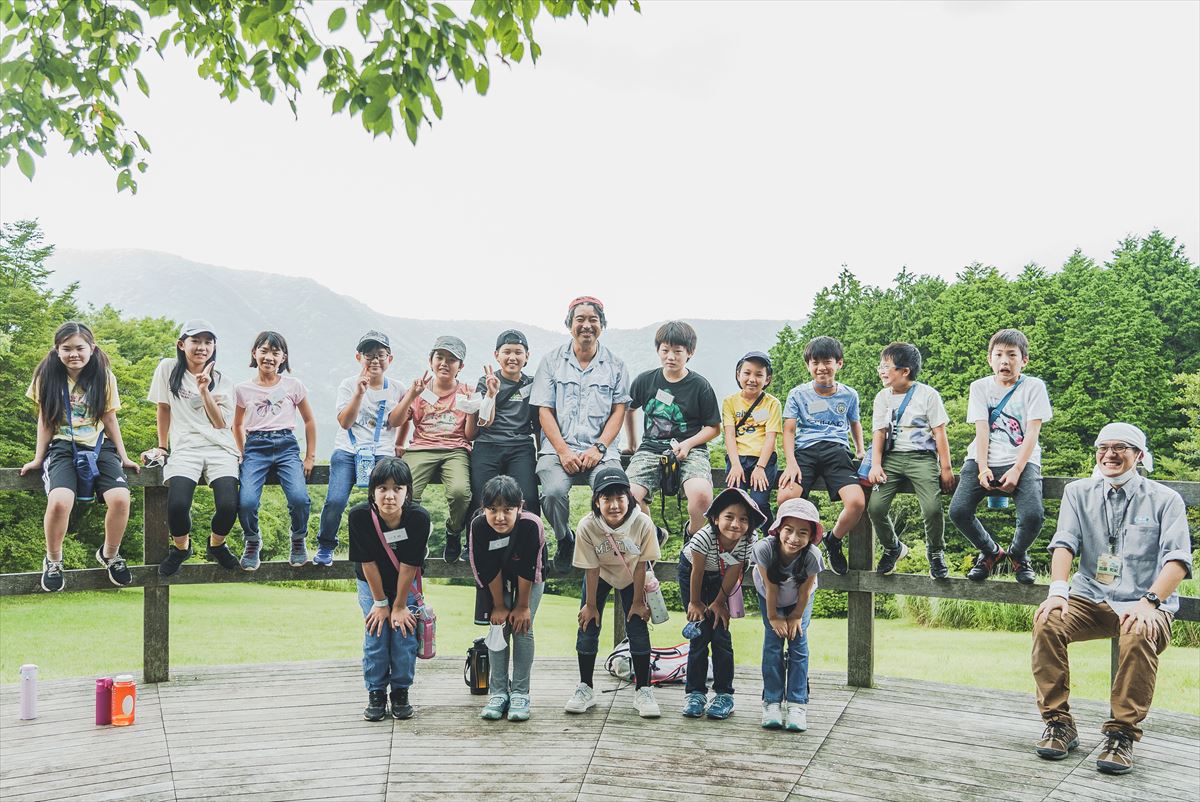
The “Hakone Town × GOLDWIN Kids Summer Camp 2022” was held between the 25th- 27th of July at Ashinoko Camp Village in Hakone Town, Kanagawa Prefecture. We look back on the three-day adventure of 16 children who joined from Hakone and other towns.
Under the bright sunflower-like sunshine, the lakeside campsite was filled with the songs of the Higurashi cicadas. The 16 children looked a little nervous but intently listened to the voice of the sun-tanned camp leader. “I only want you to observe one thing at this camp. Please remember to greet each other nicely on all occasions. All right? Then let the games begin!’
The children joined the leader and started the game by clapping their hands. If they clapped their hands twice, they formed a group of two; if they clapped four times, they created a group of four and said ‘Hello!’ to each other.
Then, the groups pretended to be trains and played rock-paper-scissors with each other. The group who lost went to the back and followed the winner. Gradually a circle of train formed, and laughter filled the space! The nervousness had disappeared into the atmosphere. The children who had only met fifteen minutes ago were now opening up to each other.
“Let’s head to our tents!” called the leader, and the 16 children responded with enthusiastic cheers.
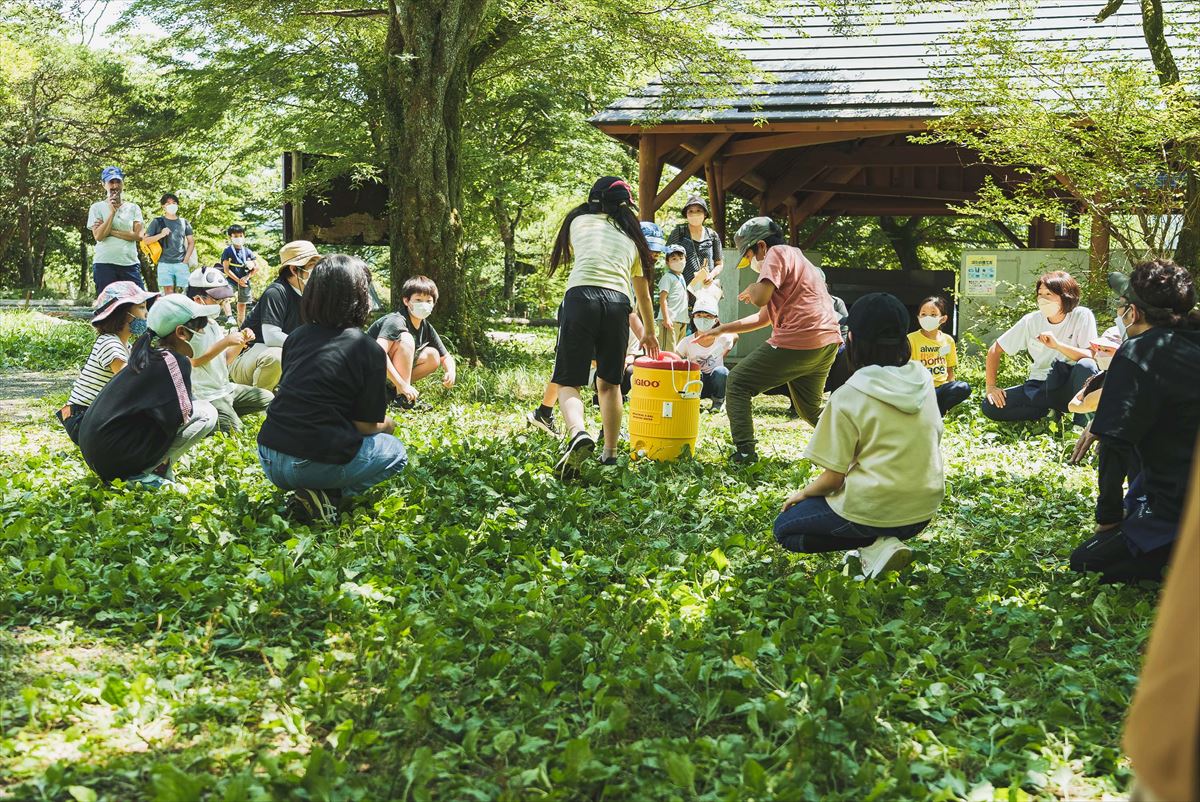
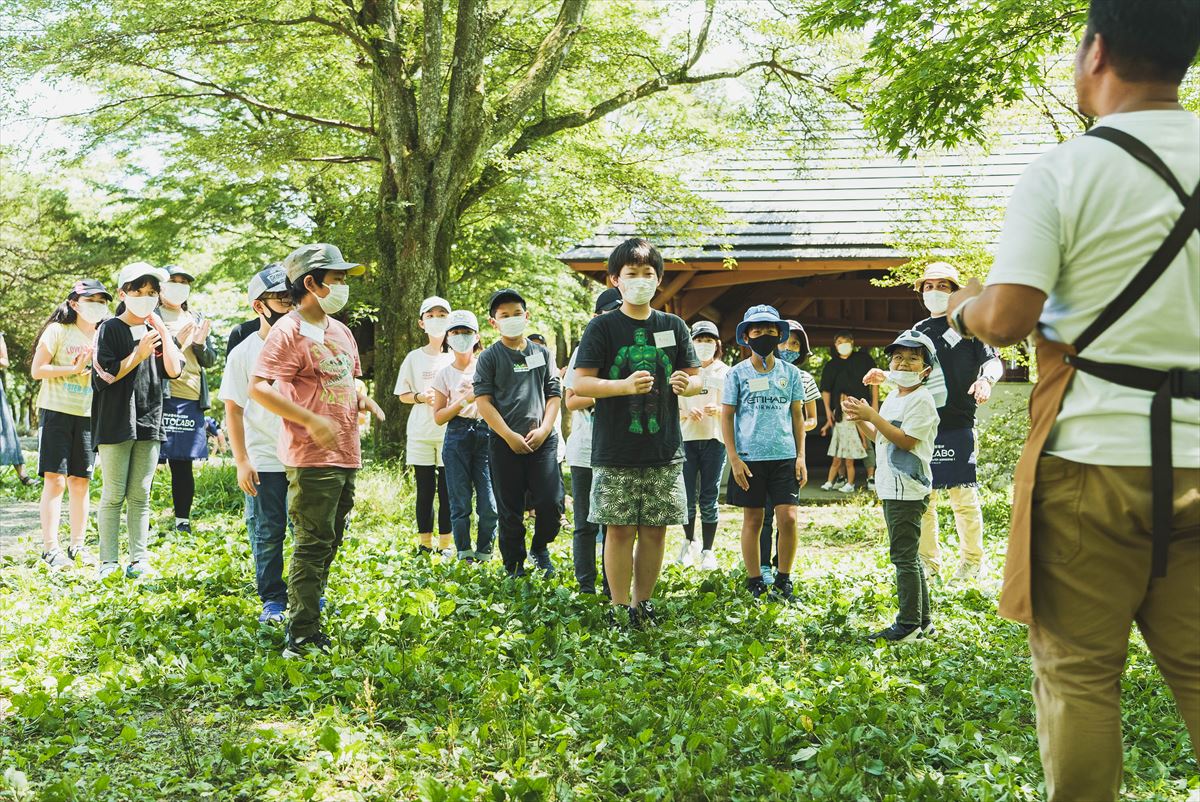
The children gather, and the game begins.
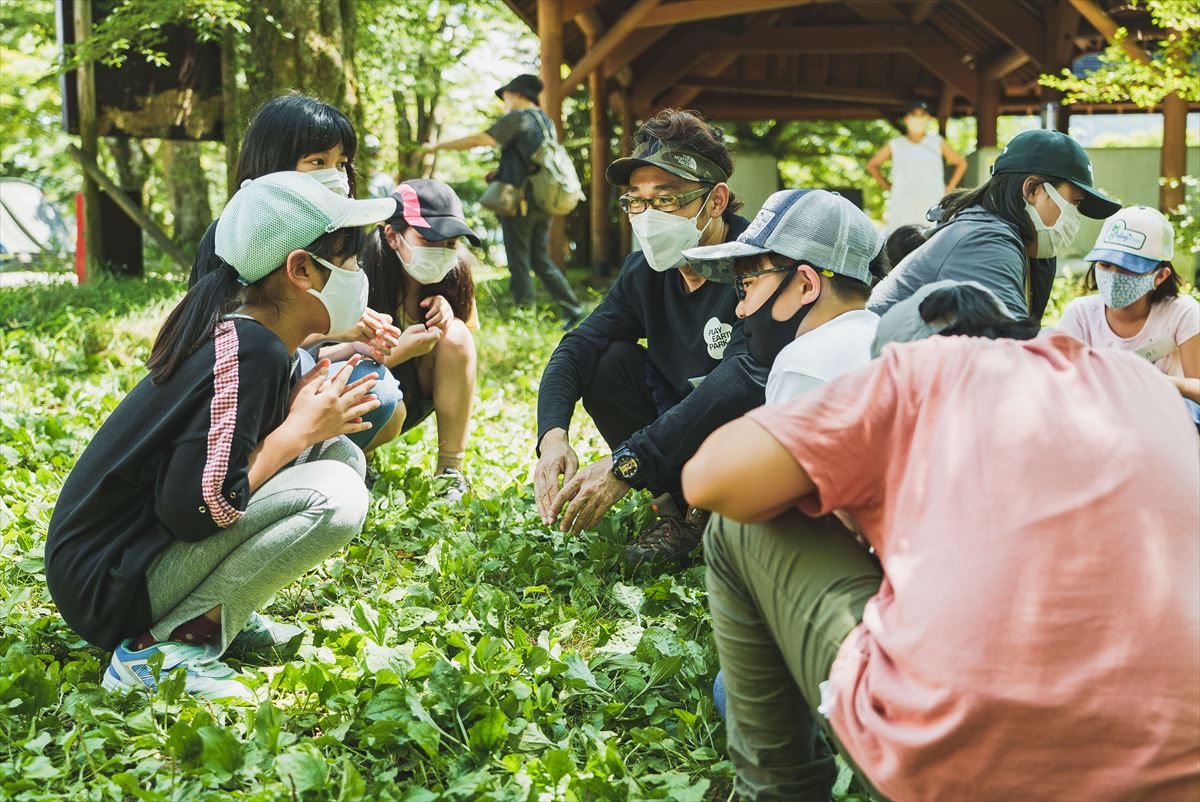
The children’s minds and bodies, as well as the atmosphere, relaxed.
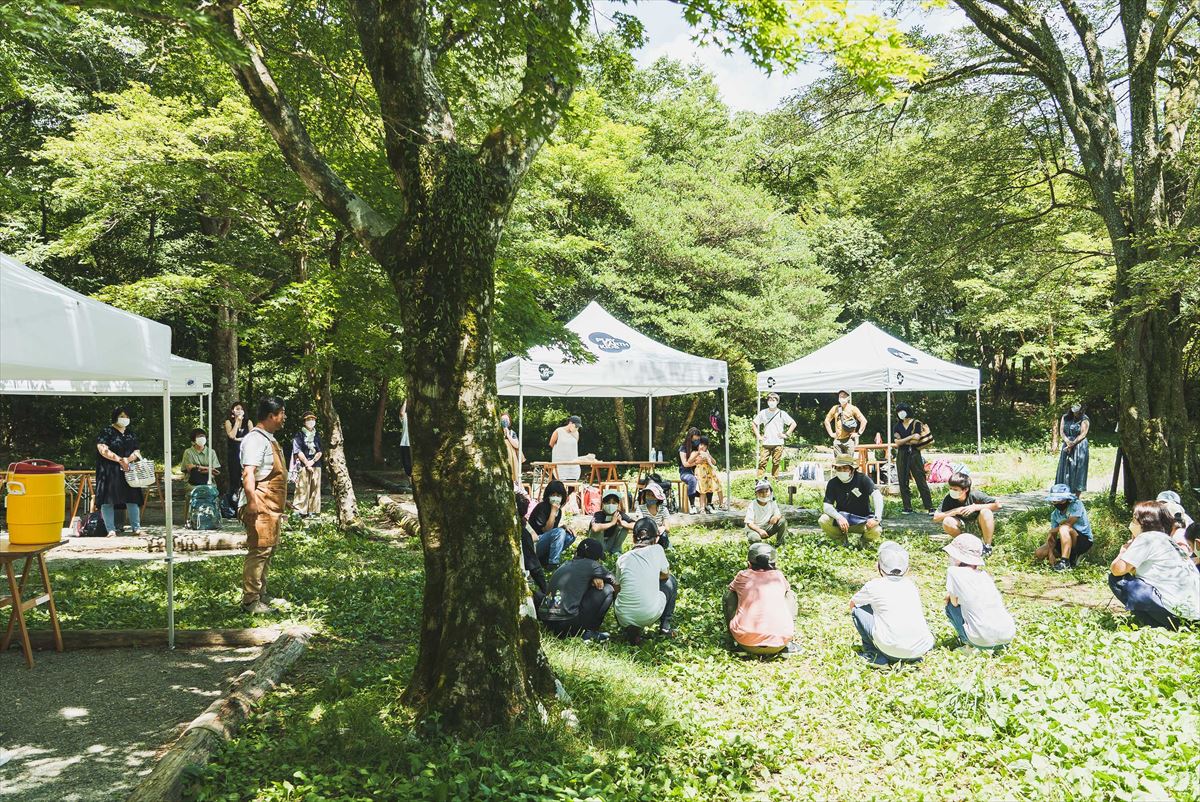
After a while, the children from Hakone and other towns were mixed and divided into three groups to start the camp.
The “Hakone Town x GOLDWIN Kids Summer Camp 2022” was held from the 25th to the 27th of July at Ashinoko Camping Village, Hakone Town, Kanagawa Prefecture. The camp brought together 16 children from grades three to six, nine living in Hakone and seven outside the town.
“The camp was first planned for the children of Hakone to find a new appreciation of the local area,” Miki Watanabe of the Hakone DMO (Hakone’s Destination Management Organization) explained. As she talked, she was already surrounded by girls. The camp offered activities such as climbing Mt Kurodake and fishing for wakasagi (smelt), visiting the Hakone Geomuseum, and experiencing traditional wooden parquetry work.
“There are three primary schools in Hakone, all of which have about ten pupils per year group. We wanted to create an opportunity for the children to get to know others, who otherwise will not have the opportunity to meet.” Miki smiled as the girls led her toward their choice of camp. Each child had a tent in their hand.

“Hakone Town receives 20 million visitors a year. However, how Hakone is experienced as a place has become semi-fixed. How should we convey the rich nature and culture that are less well known? That is why we decided to work with GOLDWIN, a company that offers outdoor activities in various parts of Japan and also focuses on nature conservation activities,” Miki explains.
GOLDWIN, which manages outdoor brands such as The North Face and Helly Hansen in Japan, co-sponsored the camp along with Hakone Town. In March 2022, prior to the camp, Hakone Town and GOLDWIN concluded a Comprehensive Collaboration Agreement on Regional Revitalization.
“One of the collaboration programs is to create experiential learning opportunities for children through contact with nature. The best way to preserve a rich environment for the next generation is to let the children experience the wonders of nature firsthand,” Mitsuhiro Fujimura of GOLDWIN told us while setting up the tent in the heat.
“Abundant nature is found only two hours away from the center of Tokyo. We want children from outside Hakone to experience this richness too. At the same time, I hope that by spending time with similar-aged children, those children from Hakone Town will realize once again that they live in a beautiful place.”

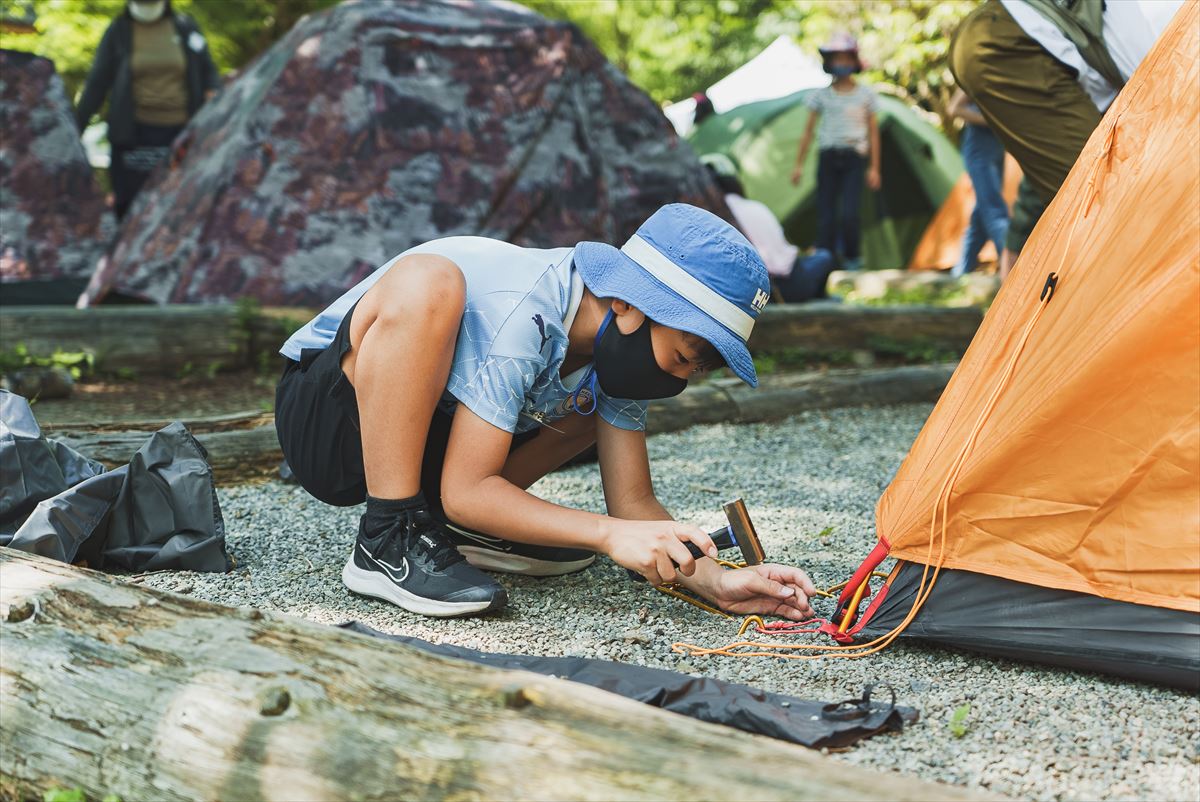
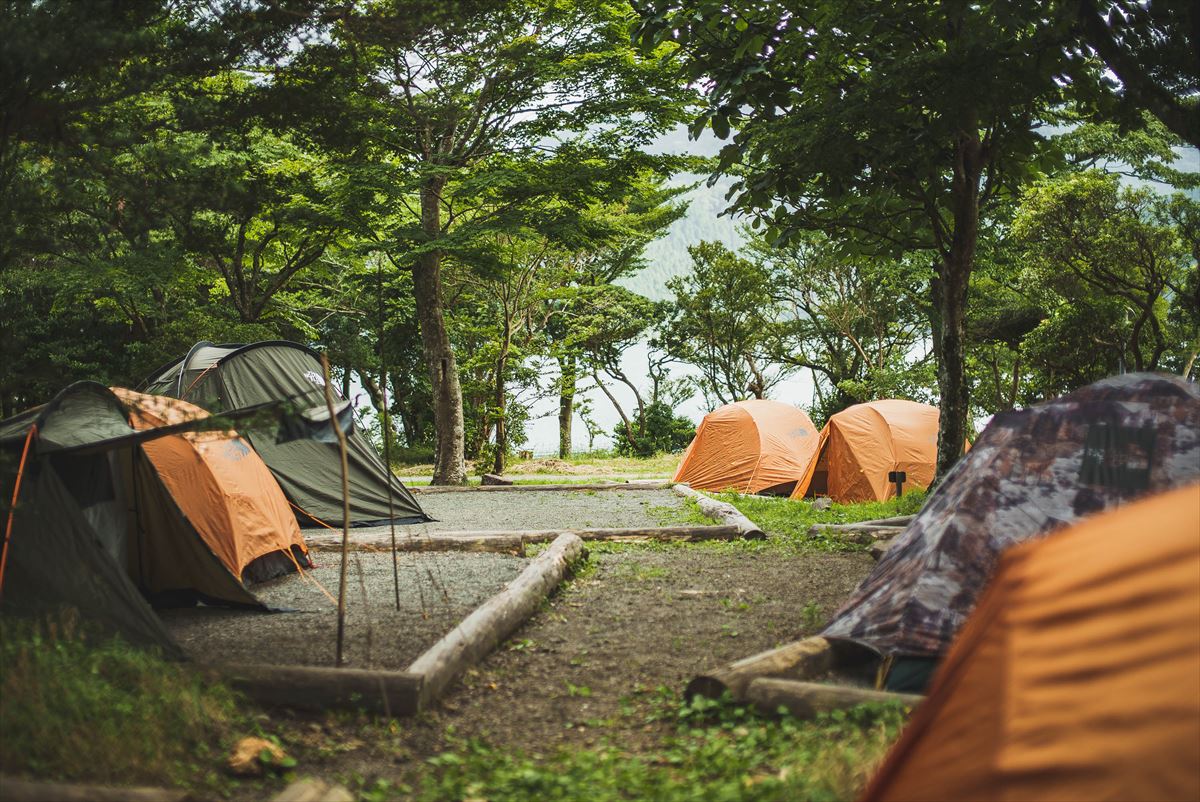
The North Face tents sponsored by GOLDWIN are handed out to the children. Each child built their secret base in a chosen place.
After setting up the tents, we strolled through the forest with a meadow to the Hakone Visitor Center. Suddenly, we were greeted with a pleasant surprise!
A man appeared with a beaming smile and said, “I heard that everyone was making curry tonight, so I came to steal a bite before everyone else!” It was the professional skier and adventurer, Gota Miura, a special guest lecturer who was scheduled to participate the next day.
He smiled as he saw the boys catching the cicadas. “The trick is to keep your eyes away from them,” he said. …… “Ask me anything about insects, mountains, or adventure!”
His twinkling eyes and his attitude quickly captured the children’s attention. The world-renowned adventure skier thus rapidly became the children’s friend.


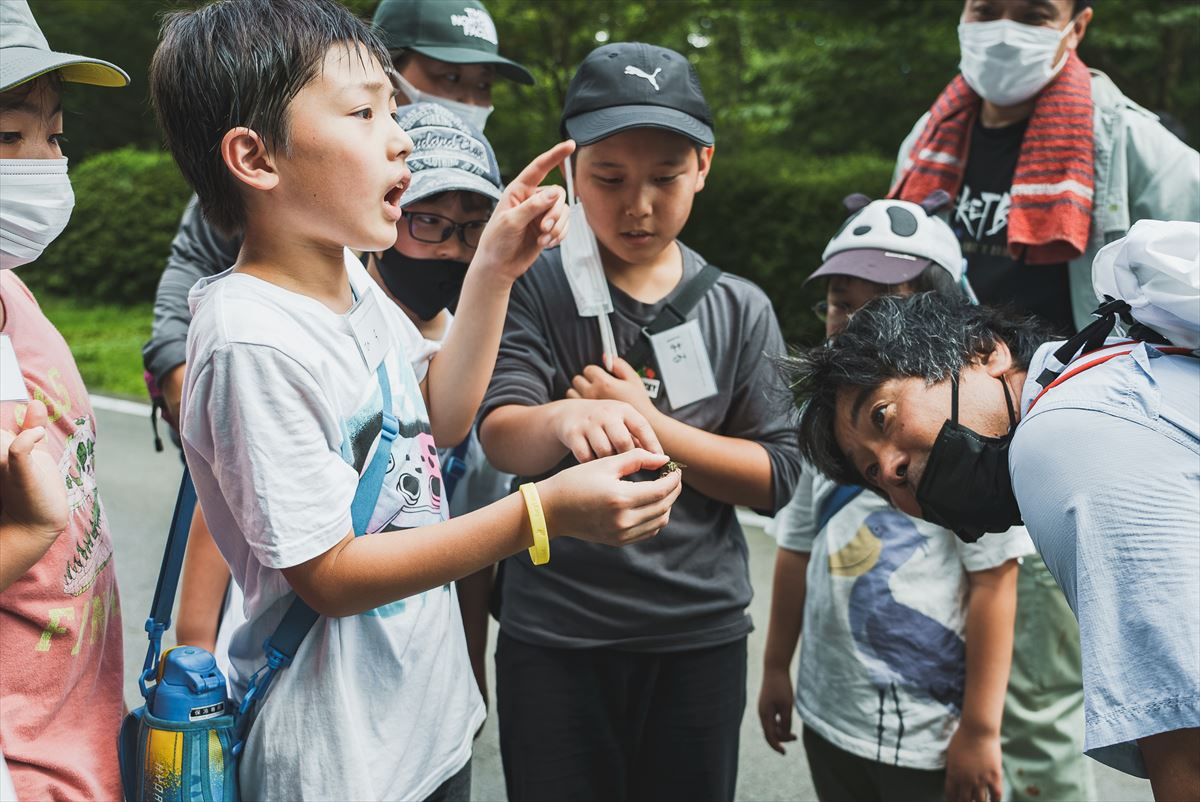


Gota Miura arrived ahead of schedule. He found a Higurashi cicada hiding like a ninja, and everyone immediately became excited. With his smile and relaxed atmosphere, Gota quickly became an older brotherly presence to the children.

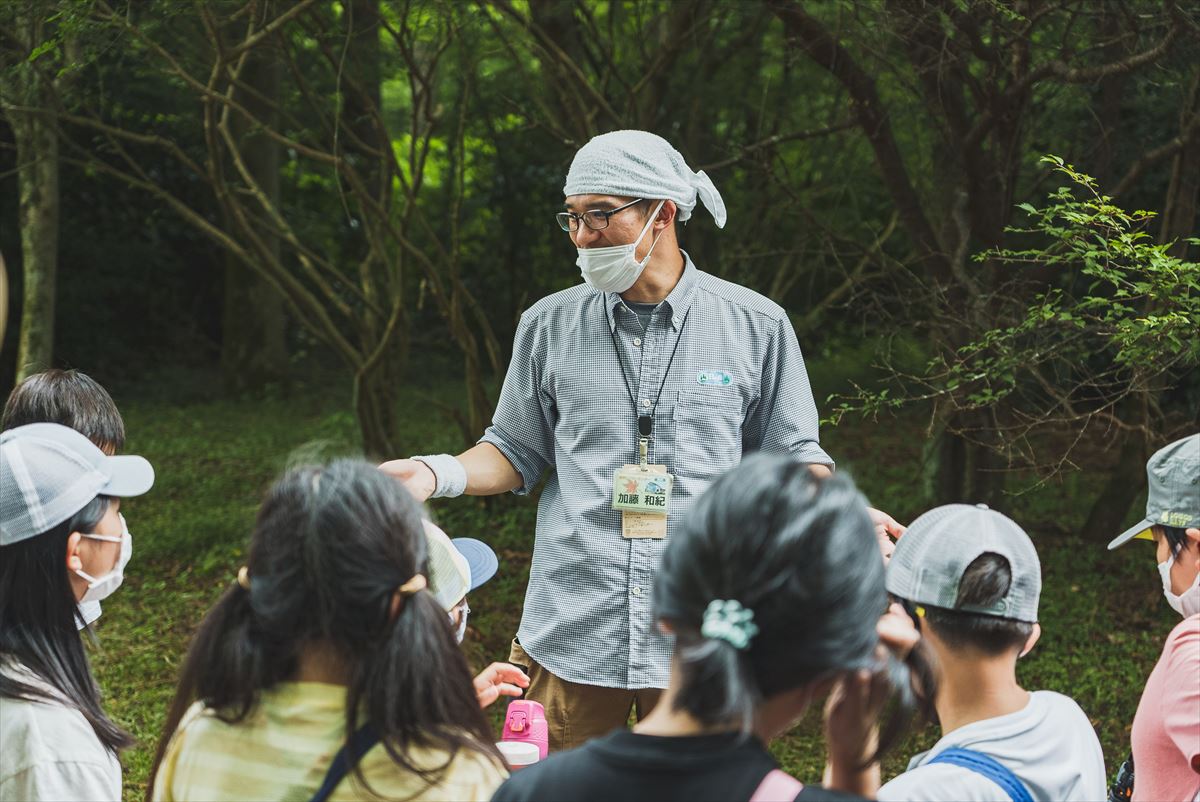
While searching for insects and other creatures, we arrived at the Hakone Visitor Center, where Kazuki Kato, the manager, awaited. He explained the unique topography of Hakone and its origins in front of a three-dimensional model.
“Present-day Hakone, surrounded by mountains, was created roughly 400,000 years ago. Do you know what the highest mountain is called?” he asks. The local children answer together with pride in their voices. “Mt.Kamiyama!”
Kazuki continued to describe in a child-friendly manner how the newest mountain, Mt. Kanmuri, formed from an eruption 3,000 years ago. The phreatic explosion then dammed the Hayakawa river and created Lake Ashi. Hakone is surrounded by volcanoes and positioned between Sagami Bay and Suruga Bay, with abundant rainfall, which leads to its wide variety of rare endemic species. After learning about the natural surrounding of Hakone, Kazuki led the children on a walk through the forest.
“We have five senses: sight, hearing, smell, taste, and touch. Let’s explore these senses in the forest,” Kazuki told the children.
Everyone touched the smooth tree surface, followed by an uneven one.
“It’s so smooth!” “It’s a crape myrtle tree, isn’t it?” “This surface feels rough.” Kazuki looked around with a beaming smile as the children excitedly shared their experiences.
“By directly touching the trees, you can learn much more than you can see with your eyes. The first bark you touched is a Himeshara tree, similar to the crape myrtle tree. And when I touch this tree, I feel the coolness,” he said.
The bark of the Himeshara tree is very thin, and the tubes where water from the roots runs along are near the surface. So, the coldness of the water is easily transmitted to the outside.
“That is how I feel, while some children may have felt the yellow cedar tree cooler. How we feel is an individual experience, so both are correct. It is valuable to explore how it feels using the senses in nature and share that experience with others.”
The children and Gota nodded in agreement.
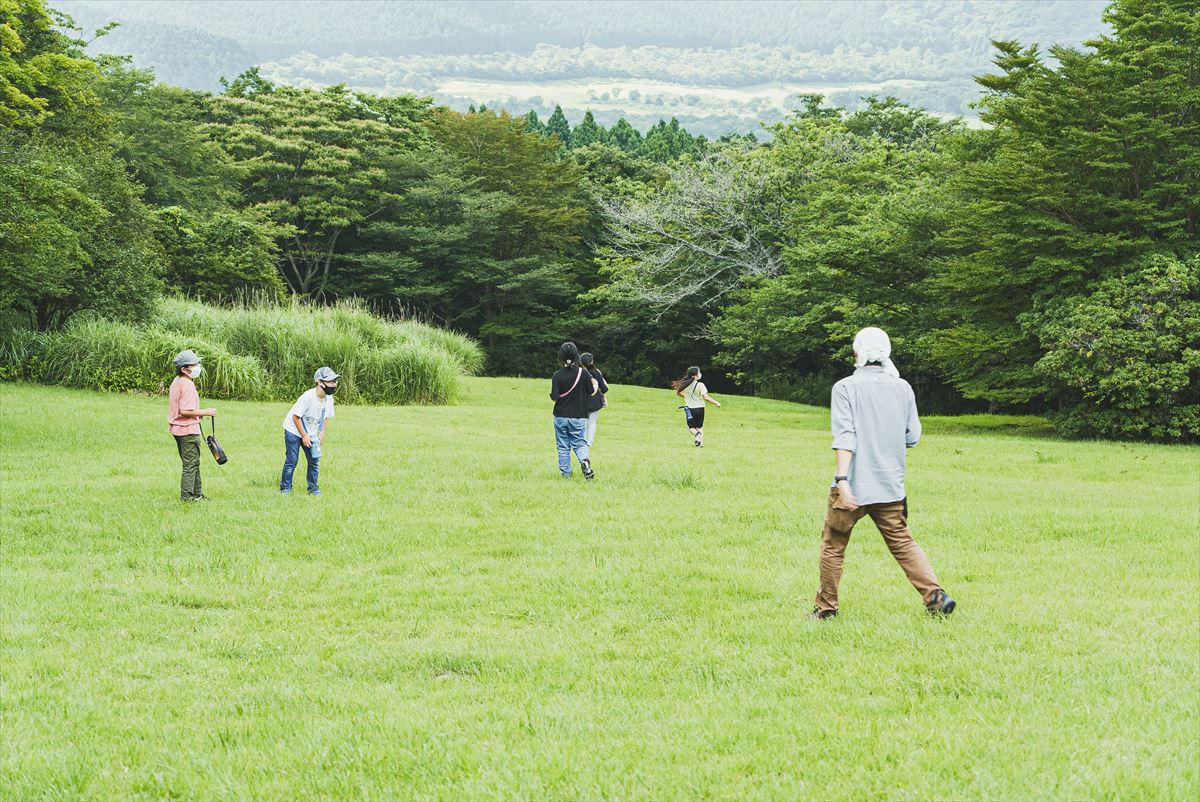
Kazuki Kato of the Hakone Visitor Center explains nature and creatures with his wealth of knowledge and humor. Hakone has many people who deeply love their hometown and are willing to pass it on to the next generation.
Back at camp, the long-awaited curry cooking began under the sunset sky. After receiving the ingredients from the camp leaders, the children were divided into three groups and started cooking. They were given ingredients of lettuce, tomatoes, carrots, onions, and eggplant. However, each group was left to decide how to prepare and distribute the ingredients. Gota laughed and cheered the children, who looked at each other anxiously. “There is no such thing as a failed curry in this world!”
With these words, the children regained their smiles and busied themselves washing vegetables, chopping them into small pieces, and laying plates.
In one of the groups, the children were counting numbers in front of a pot, “It says to cook for five minutes, but we don’t have a clock, so I’m counting!”
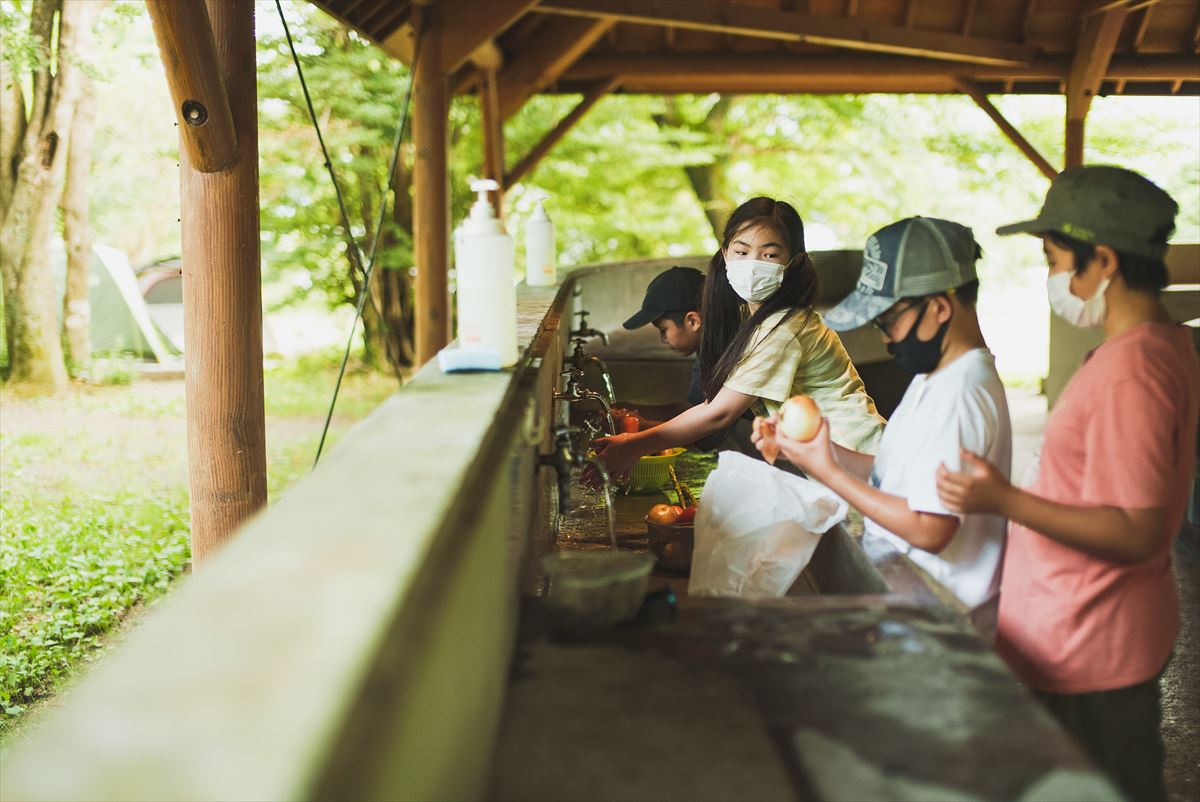
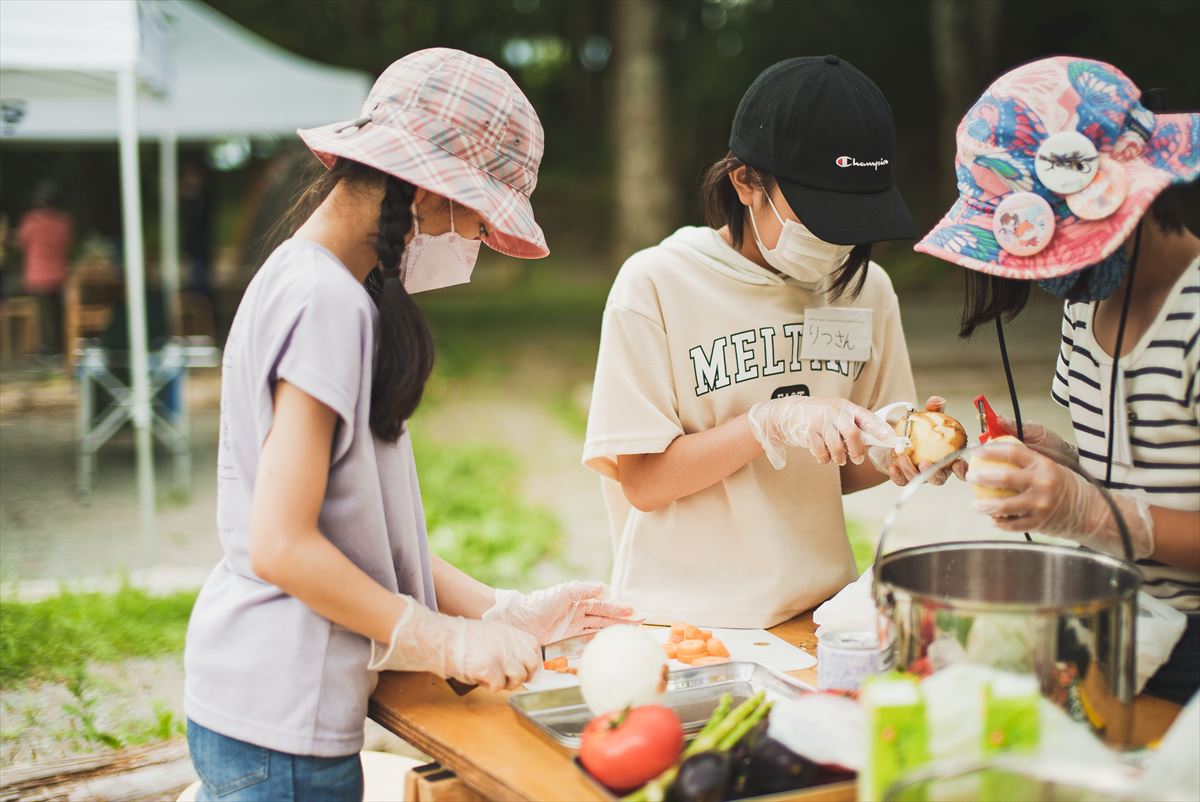
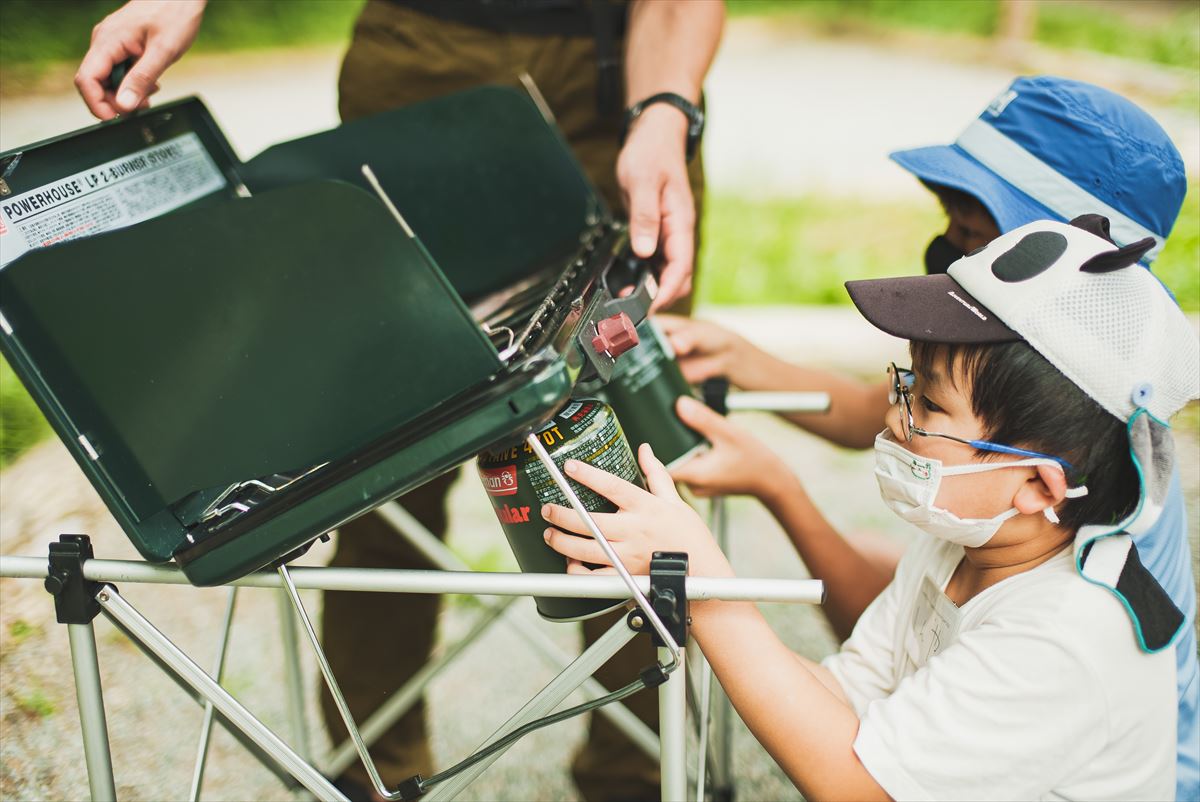

Amid this, the western sky was suddenly enveloped in dark clouds, and the eastern sky turned red from the afterglow.
“Tomorrow might be rain,” Gota said. The children asked him why.
“The western sky is cloudy, and a cap cloud covers the top of Mt. Fuji. We can also see the swallows flying low in the sky. When humidity increases due to an approaching low pressure, the wings of insects absorb moisture and become heavier, making them unable to fly high. Then, the swallows that prey on them fly low.”

After playing to their heart's content, they made curry working as a group. As soon as it was simmering, the children, full of curiosity, picked insects and discovered a pair of pheasants. While playing with the children, Gota told them stories about the wonders of nature.
As dusk fell, that irresistible aroma wafted through the air. With the traditional words of blessings, “Itadakimasu!” the children began to eat with gusto. Gota joined each group, quickly ate three curry plates, and exclaimed, “Each is different, even though made from the same ingredients!” “Group A’s curry brought out the gentle sweetness by chopping the vegetables finely. Group B’s curry was made by simmering the roux thoroughly, giving it a soup-curry-like flavor with a punch. Group C’s curry had a rich thickness from the potatoes. We can agree that it can never go wrong with curry!”
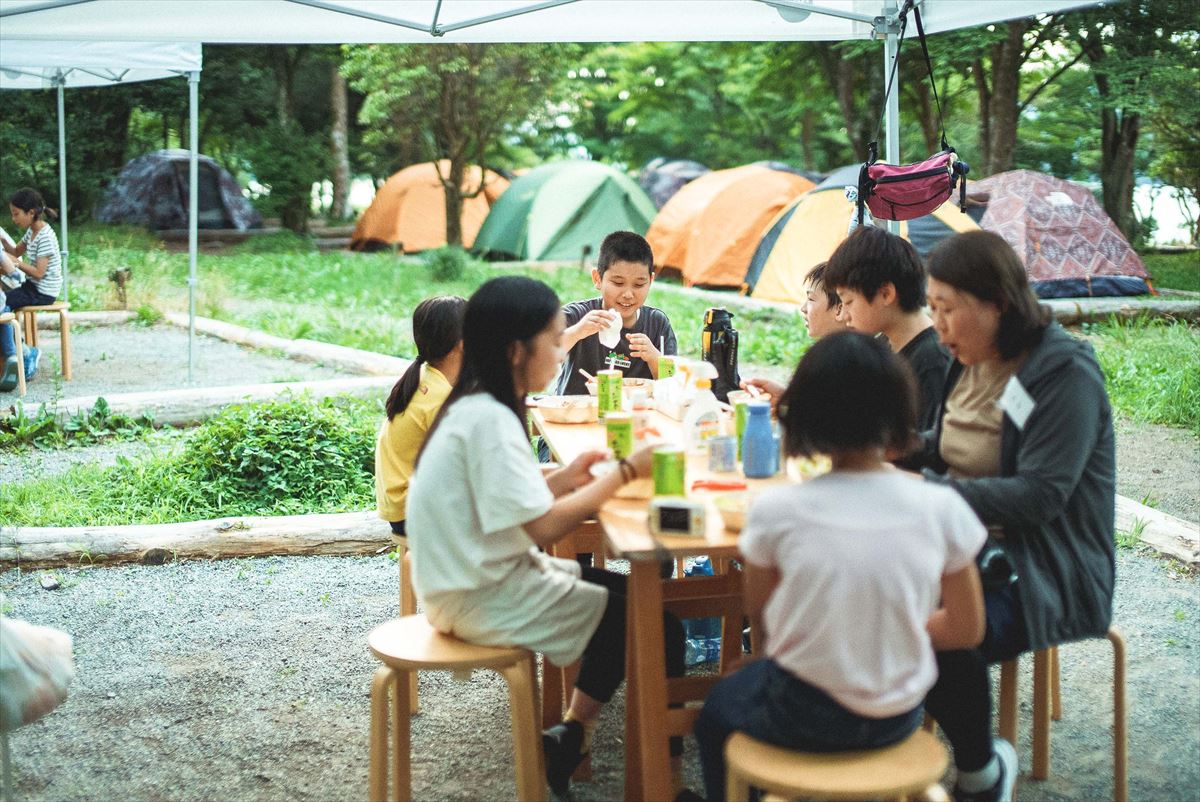


After dinner, we went to the night forest. At first, it seemed too dark to see anything, but the eyes gradually adapted when the lights were off, and the night forest showed itself. “It is harder to distinguish the colors in the dark, but the silhouette of the leaves backlit by moonlight stand out clearer than in the bright daylight,” said Sota Tsukushi of Hakone Visitor Center as he pointed out the insect bite marks on the leaves. Then he told us a tale.
“When I walk through the forest with kindergarten children, they always say they want to see a giraffe. Everyone knows that there are no giraffes in Japan….,” he spoke in a cheerful voice, then drew a deep breath.
But is that actually the case……?
Sota continued. “Just because no one has ever seen them doesn’t mean they are definitely not there. Let’s find the giraffe tonight using our eyes, ears, and imagination!”
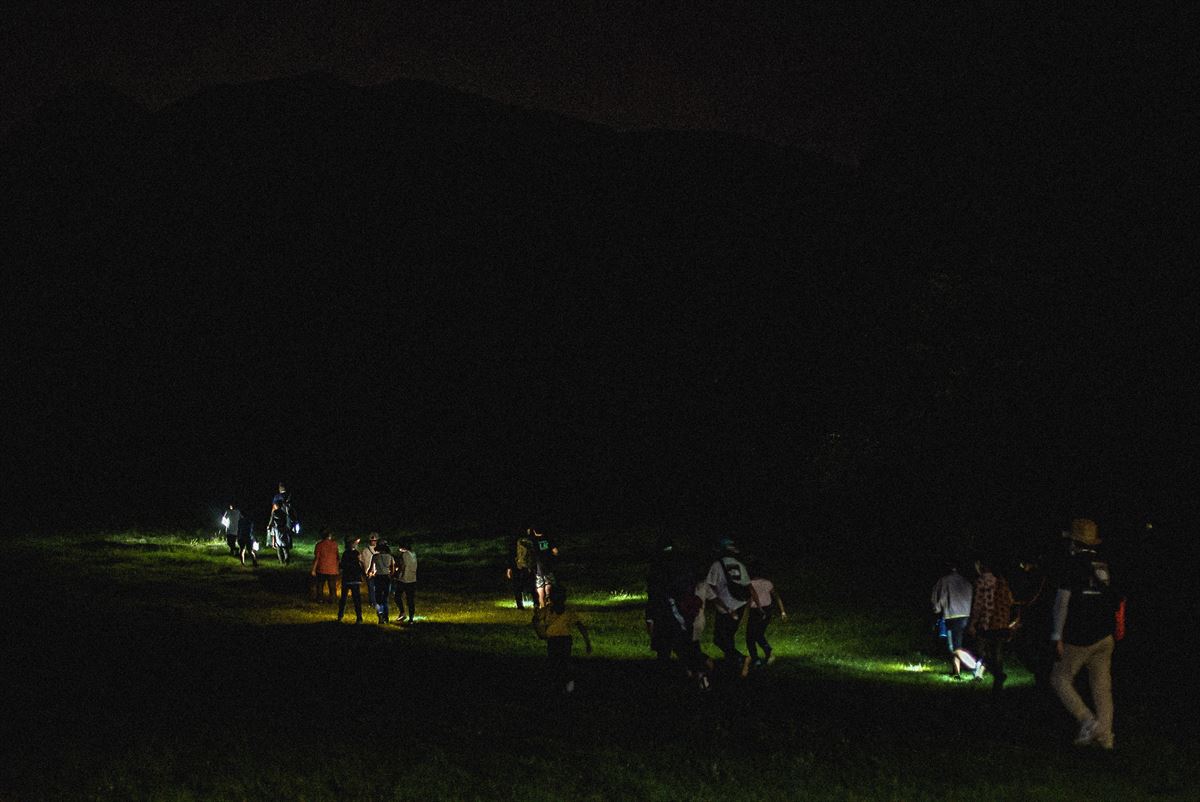
Then, we ventured into the forest at night. We had walked through the same forest during the day, but there were no sounds of the cicadas now, and the occasional birds’ call sounded very different. We turned the lights off and walked hand in hand with newly made friends.
Suddenly, we heard a loud singing voice! “One day, in the forest!…” A female camp leader sang out against the darkness. The nighttime forest was filled with laughter at the sound of her out-of-tune song.
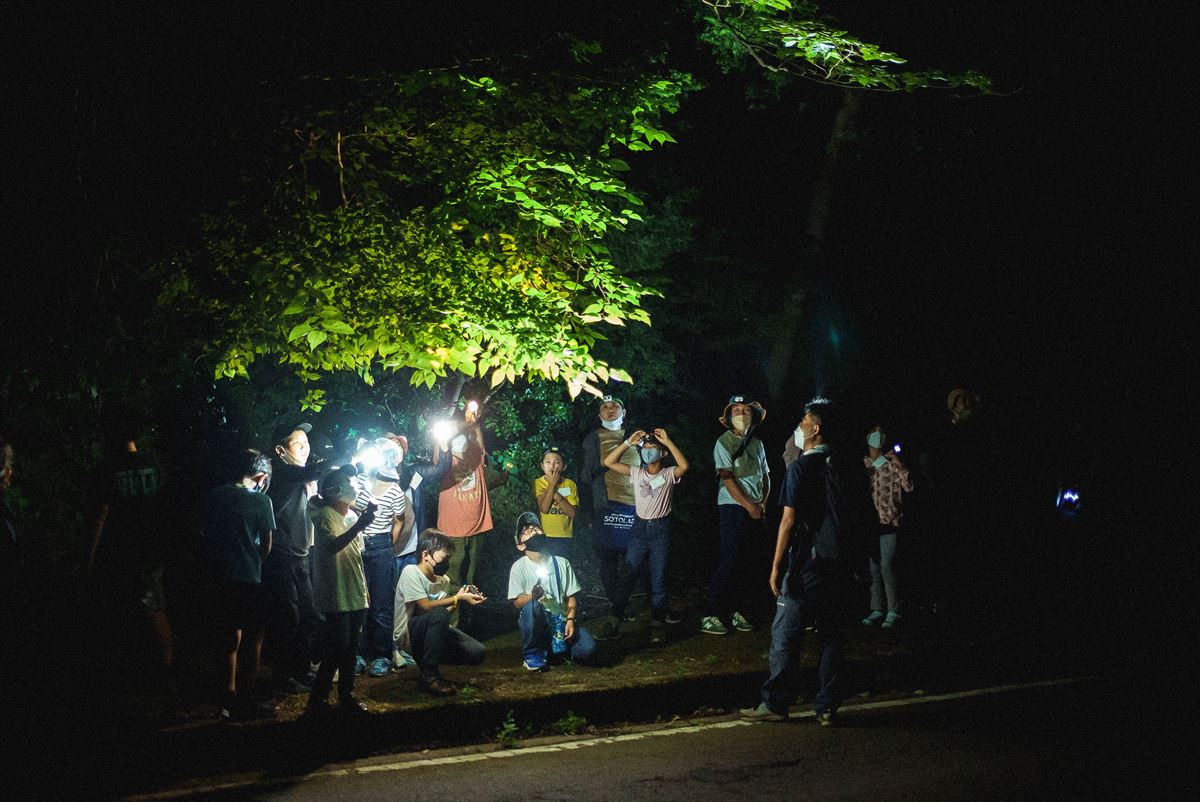
A walk in the dark forest after dinner. The forest at night appears very different from the daytime, creating a mysterious atmosphere that is scary and fun.
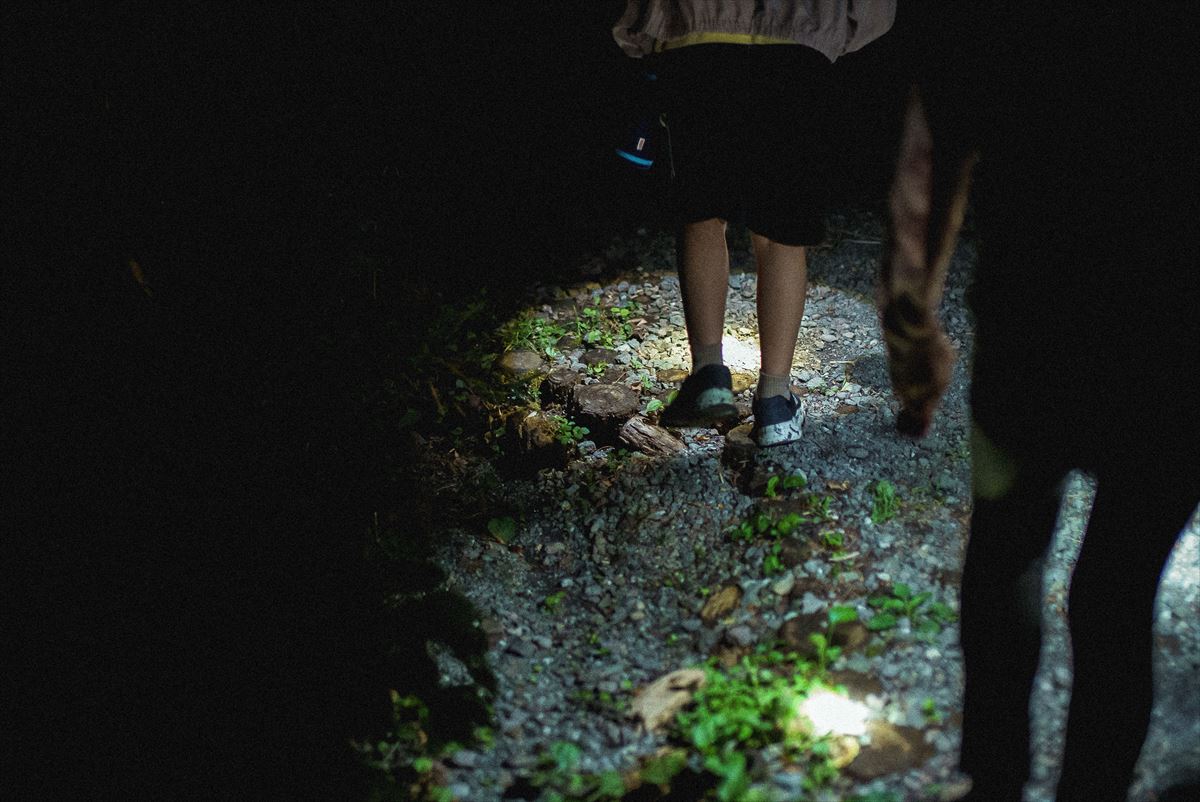
Then, we took a bath, returned to the tent, and said our good nights. However, the rain, which started earlier that night, gradually became heavier.
For some of the participants, this was their first time experiencing camping. On most camping trips, several people would sleep in one tent, but this time, due to the current situation (post-pandemic caution), each person slept in one tent.
The rain became heavier, and the wind shook the tent. It reminded me of the uneasy feeling I had when I first slept in a tent alone. I wondered how the children were feeling on their own.

A long, long night dawned, but the rain continued. We had no choice but to cancel our planned climb that day. We went to the multipurpose space in the campground, which was as spacious as a gymnasium. The forecast was unfavorable, so we decided to sleep there for the second night.
Fortunately, the children kept a positive attitude. As one of the adults watching over the camp, I was struck by their enthusiasm. There was an “air of comradery” who made it through the trying night. They were making a stronger connection, not just getting used to each other.


After a relaxing session of gymnastics and games, Gota began his slideshow. The adventure lecture, titled “Each Everest,” started with an episode recalling when he was 11 years old. One morning he was woken up by his father, Yuichiro Miura, also a professional skier and a renowned alpinist who climbed Mt Everest at age 80. “We are going to the highest mountain in the African continent, Mt Kilimanjaro.” And that is how Gota became the youngest ever to climb Mt Kilimanjaro in the world. Later he participated in the Olympic games as a skier and climbed Mt Everest twice. With magnificent photographs, his presentation showed how he forged his life by climbing mountains.
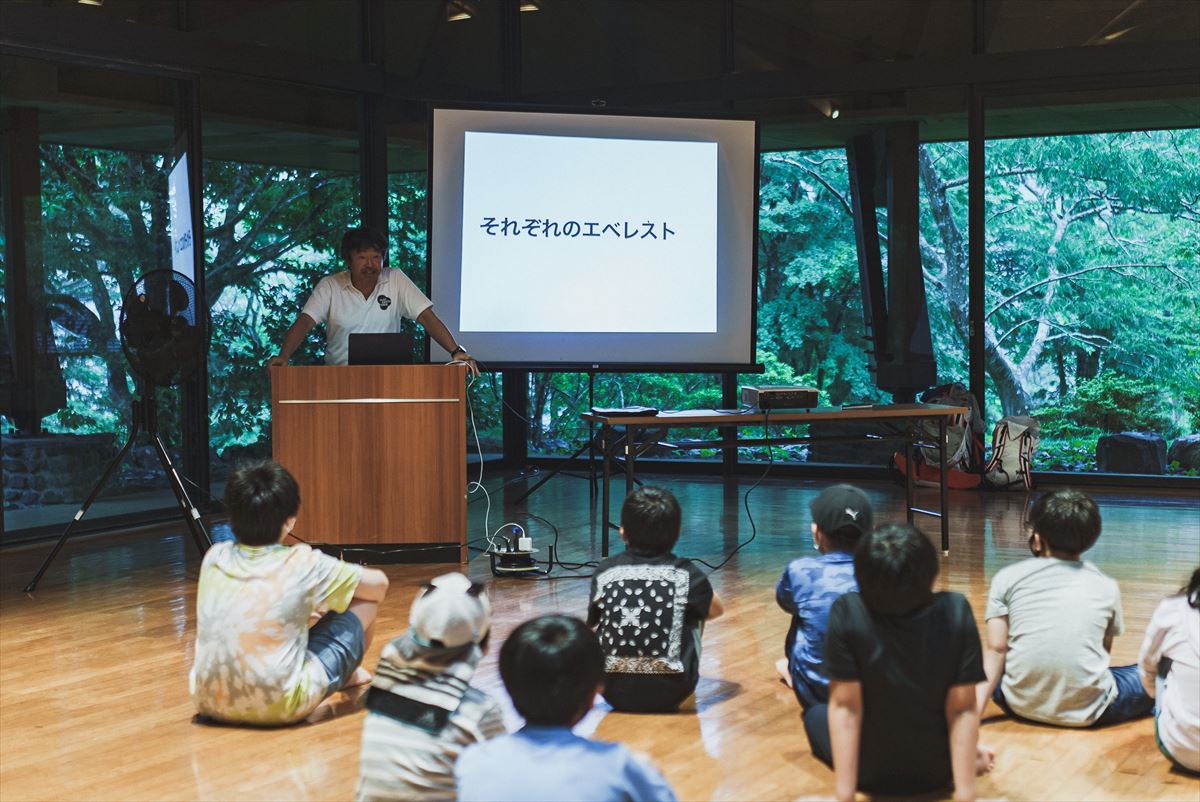
He then spoke gently to each of the 16 children. “What do you like? What are your interests?”
I like insects.
I like baseball.
I enjoy spending time with my family.
After he listened to the children’s answers, the adventurer continued.
“Have you ever thought about instinct and rational thinking?” Gota explained that “what you like” is an instinctive desire, the most primitive sense necessary for life. “If instinct is what you want to do, then rationality is what you should do.”

Then, he continued to ask if homework was instinct or rational? What about reading?
“When I talk like this, it may sound like instinct is vital, but rationality is important too.”
Gota, at 11, who loved living creatures, rubbed his sleepy eyes and traveled to Africa, hoping to see elephants on Mount Kilimanjaro. Although he initially did not love the mountains, he gradually fell in love with them as he learned skiing.
“So I followed my instincts and climbed mountains, but as I continued, I found myself in situations that instinct alone could not help.” He encountered numerous hardships with complex rock faces, avalanches, drastic climate changes, and even a hidden crevasse on Everest.
“It’s instinctive to fear them. However, as we aim for the summit, we must unravel our fears individually and find a way to deal with them. What is needed here is the strength of rationality. In this way, we gradually gain experience and confidence. In other words, acquiring rationality in the name of courage, even fear which is an instinct, can be controlled.”
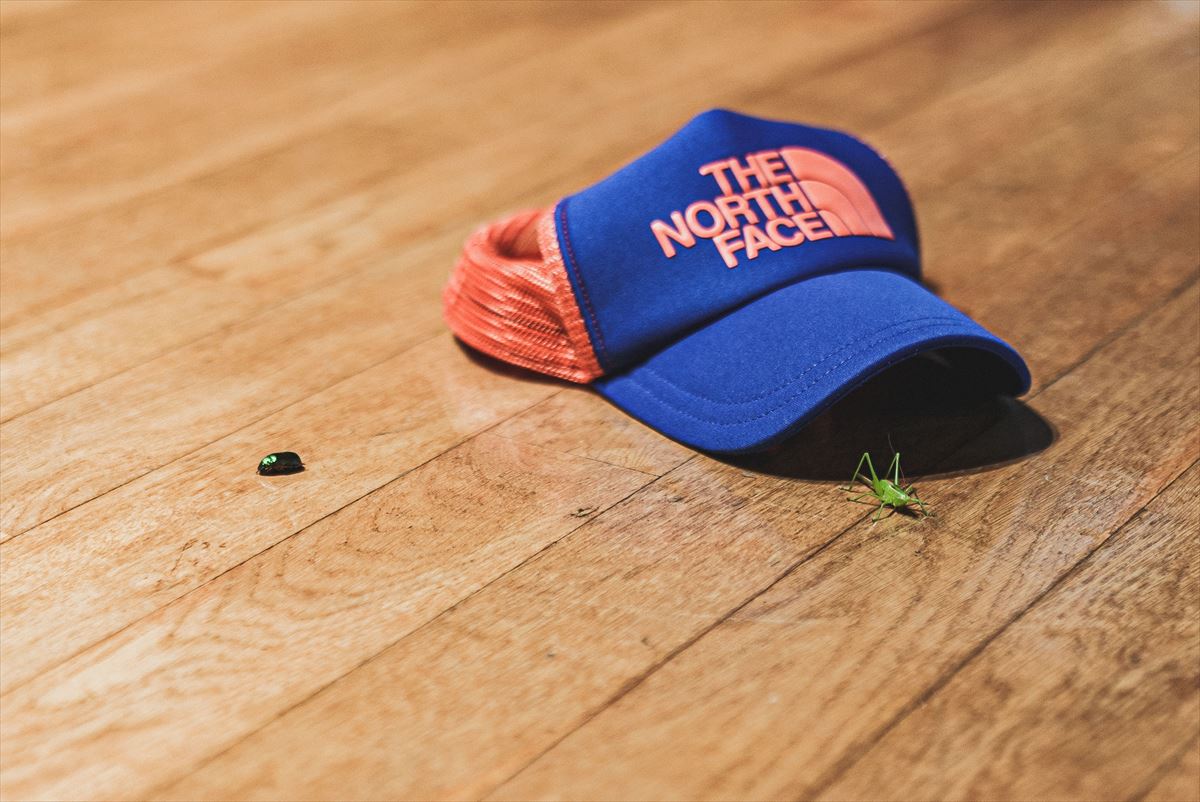
Not only the children but the grownups all listened intently to the adventurer’s words. “Then, what makes you individual?” Gota posed a question. His words echoed in the quiet space.
Then, he continued. “We are made of ‘what we like’. You cannot suddenly like something just because someone tells you to like it. Equally, you cannot suddenly dislike curry even if you are told to dislike it. And, people are made up of ‘what you have done up to now’. By overcoming the stormy night, you have all become stronger than who you were yesterday. People are made from the accumulation of such experiences and overcomings. ‘The courage to overcome what you are afraid of’ also makes us who we are.”
“Finding what you love, being honest and sincere about it, and having pride in pursuing what you love. I learned these from my adventures. Not everyone has to like mountain climbing. But camping is a great opportunity to realize what is important to you.”
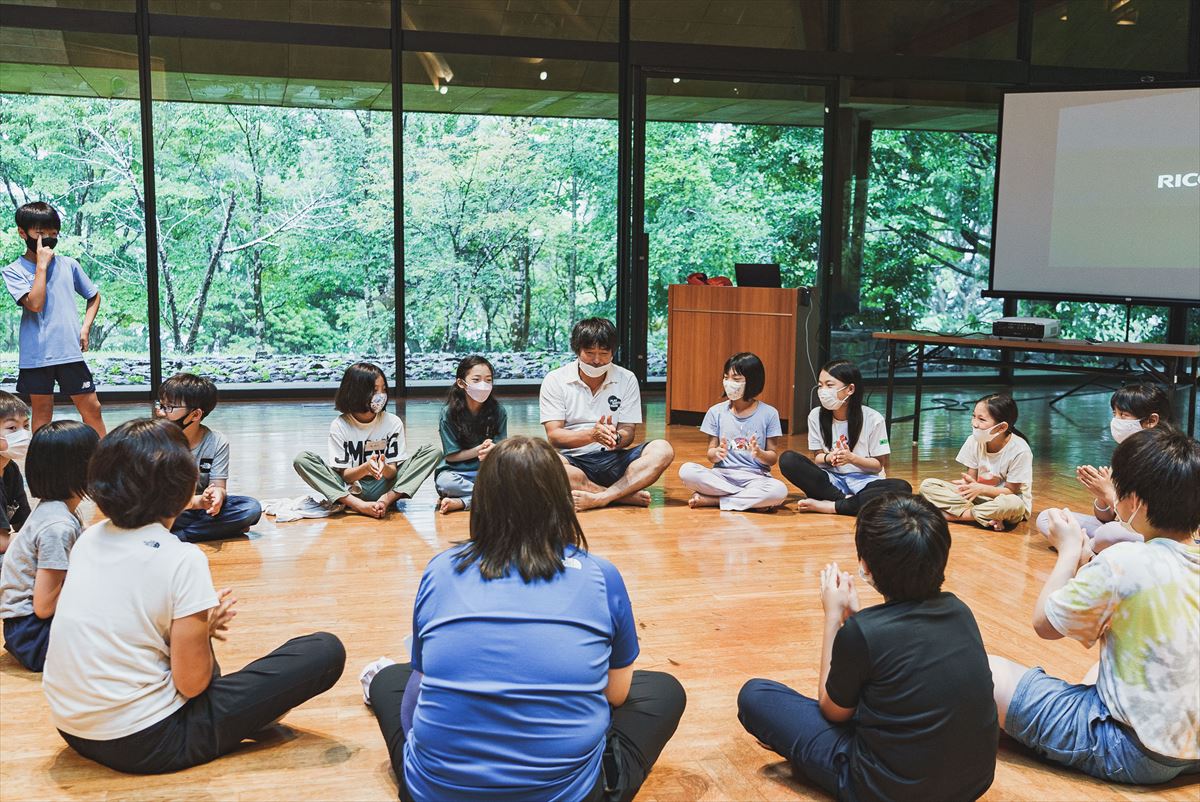
After a stormy night, the long-awaited morning arrived. Unfortunately, rain forced a change in the program, but Gota Miura extended his time to give us an adventure lecture. We later saw from the children’s letters that the adventure lecture left the strongest impression on them.
The rain continued to fall, sometimes hard, sometimes softly. A boy in the third grade who knows a lot about insects told us, “When the rain gets weaker, the Higurashi cicadas start to cry.” Sometimes there were glimpses of sunshine through the clouds, but the rain never stopped.
The walk to Owakudani was cancelled in the afternoon, and Sota Tsukushi, who had guided us last night, came over to teach us a game of making a map of Japan using large ropes, followed by lantern making. By this time, the children, who had only met through this program, had become as close as if they were old friends, with a caring atmosphere for the younger ones. The staff continued to study the weather forecast while overseeing the children.
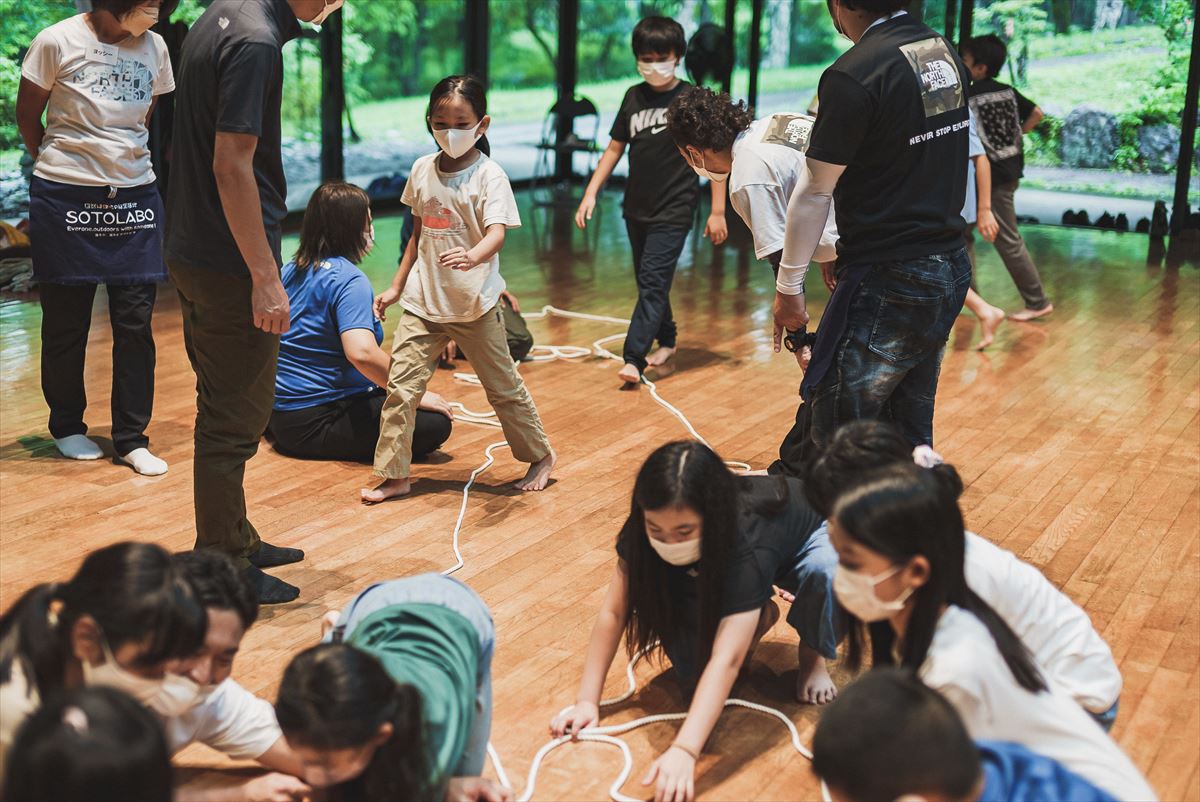
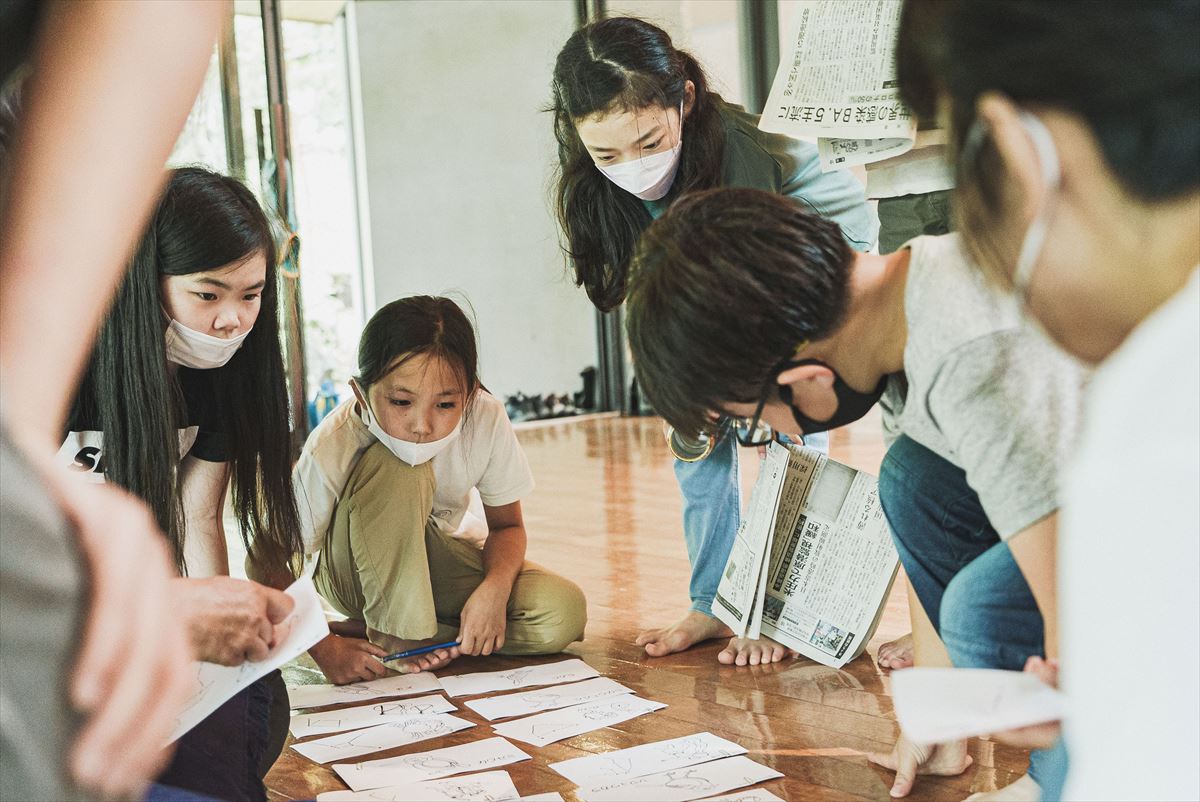
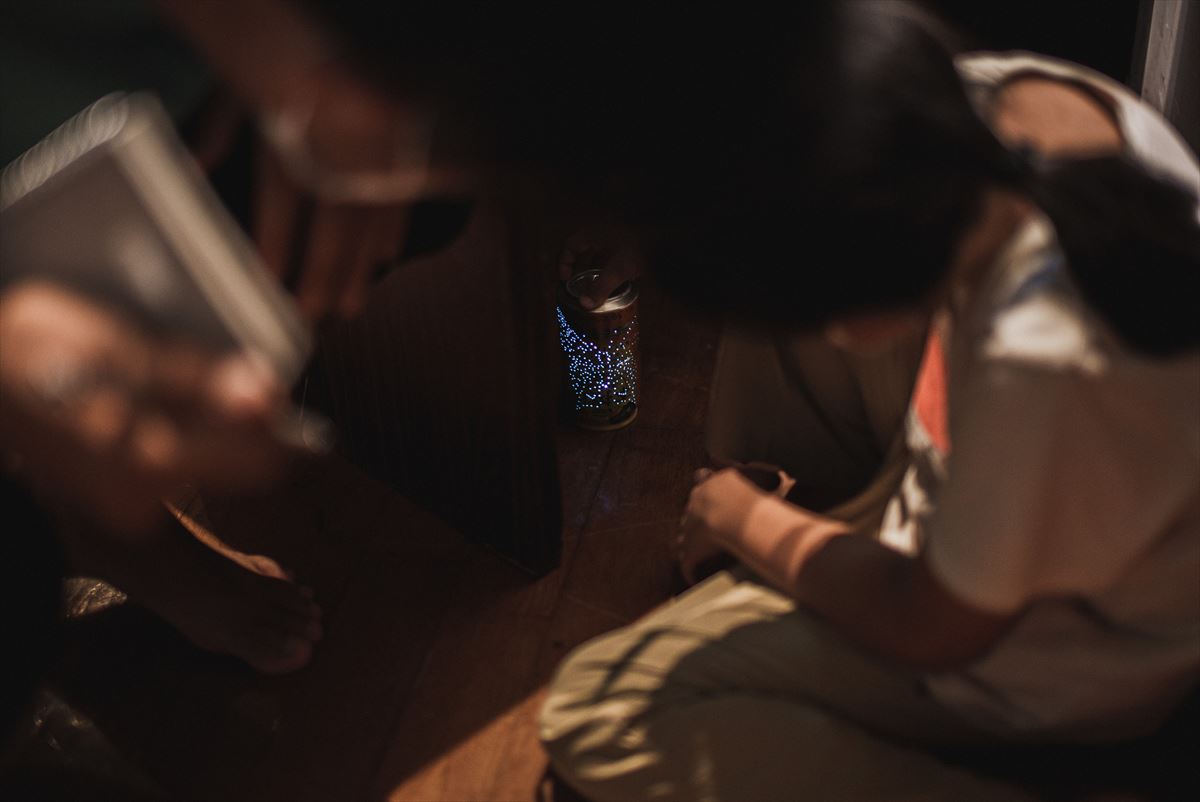
The map of Japan was made using a large rope. Each participant presented their favorite place and the reason for it. After that, they made lanterns out of empty tins. After the rain eased a little in the evening, we returned to the campsite to make hamburgers for dinner. Later, the candle-lanterns and tin-lanterns were lit, and we gathered around them.


Gentle rain continued on the last day of the camp, regardless of our prayers for it to stop. The smelt fishing, which the children had been particularly looking forward to, was also canceled. Instead, we took a walk in Owakudani while the rain eased off. Up we went in a ropeway while remembering what Kazuki told us. “The smell of sulfur from the volcano disappears when an eruption approaches, so pay attention to the change of smell.”
By the time we left the Hakone Geomuseum, the rain had stopped. I tried to take a few pictures of the children with the plume of smoke in the background. The children, now great friends, played with each other in front of the camera. Just as I finished taking two pictures, a sudden downpour of rain came.
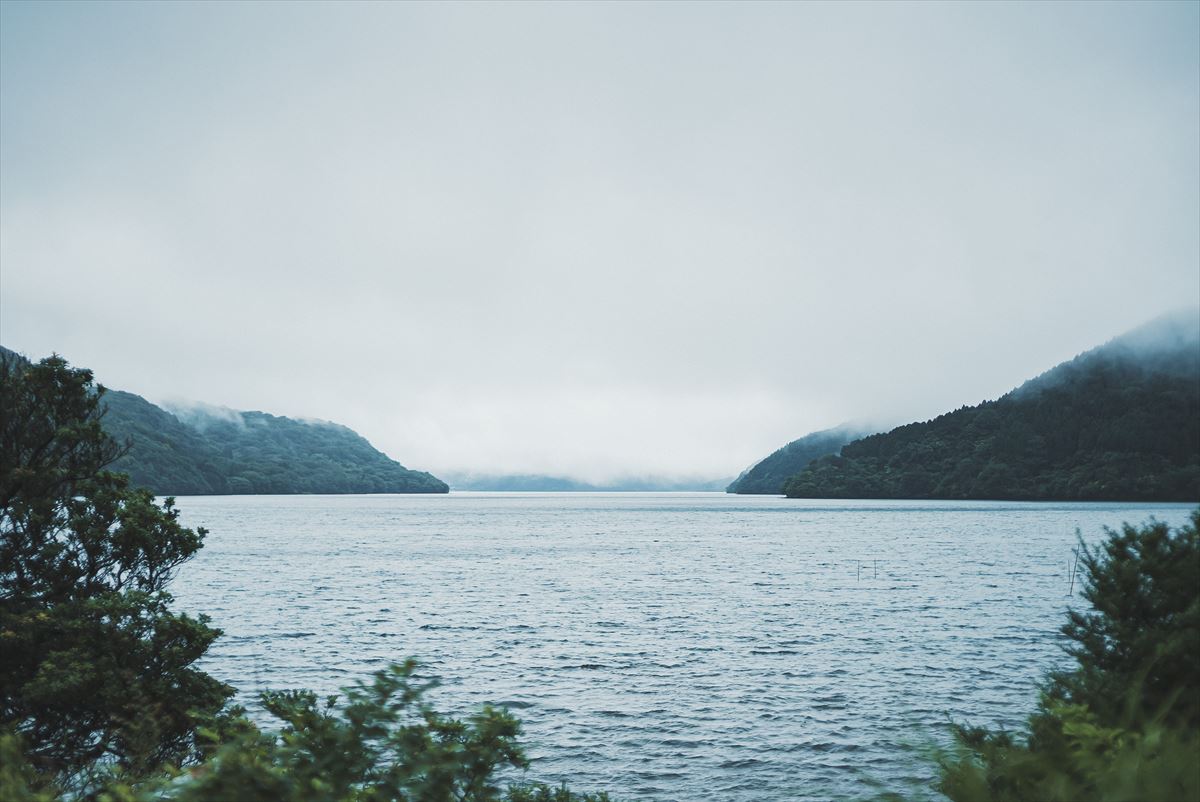
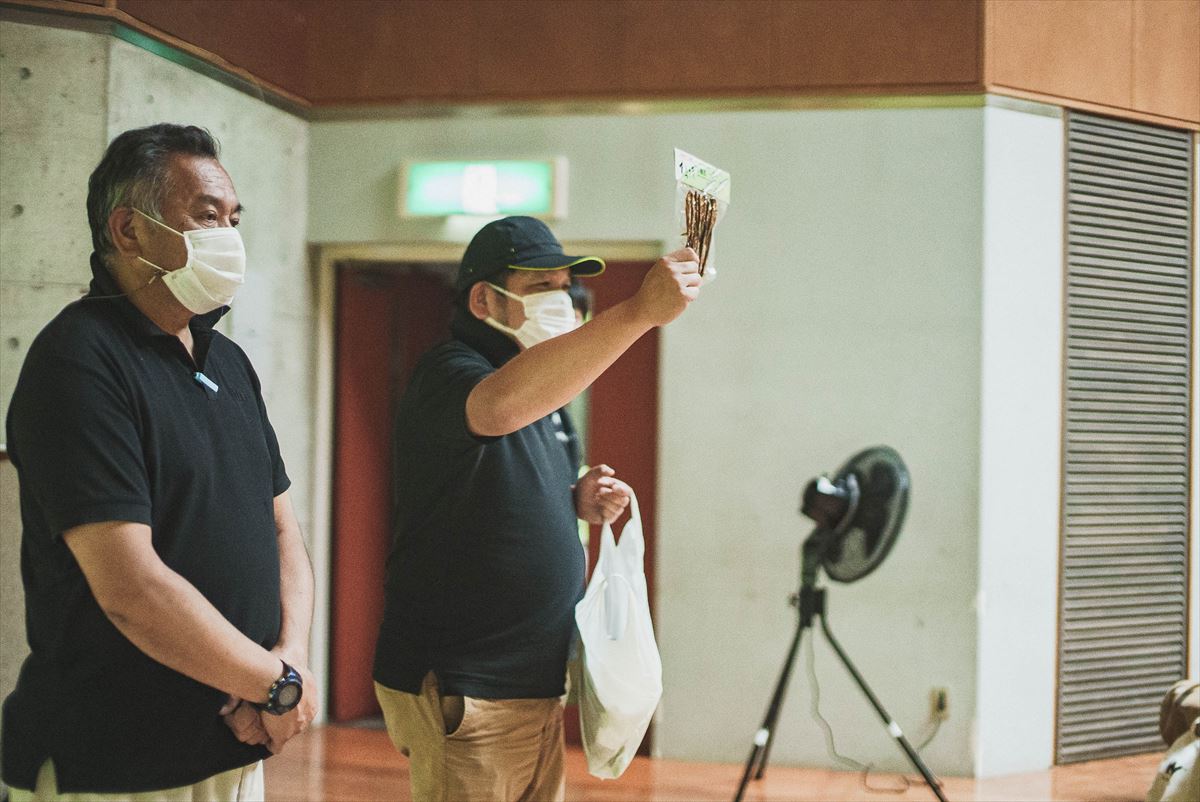
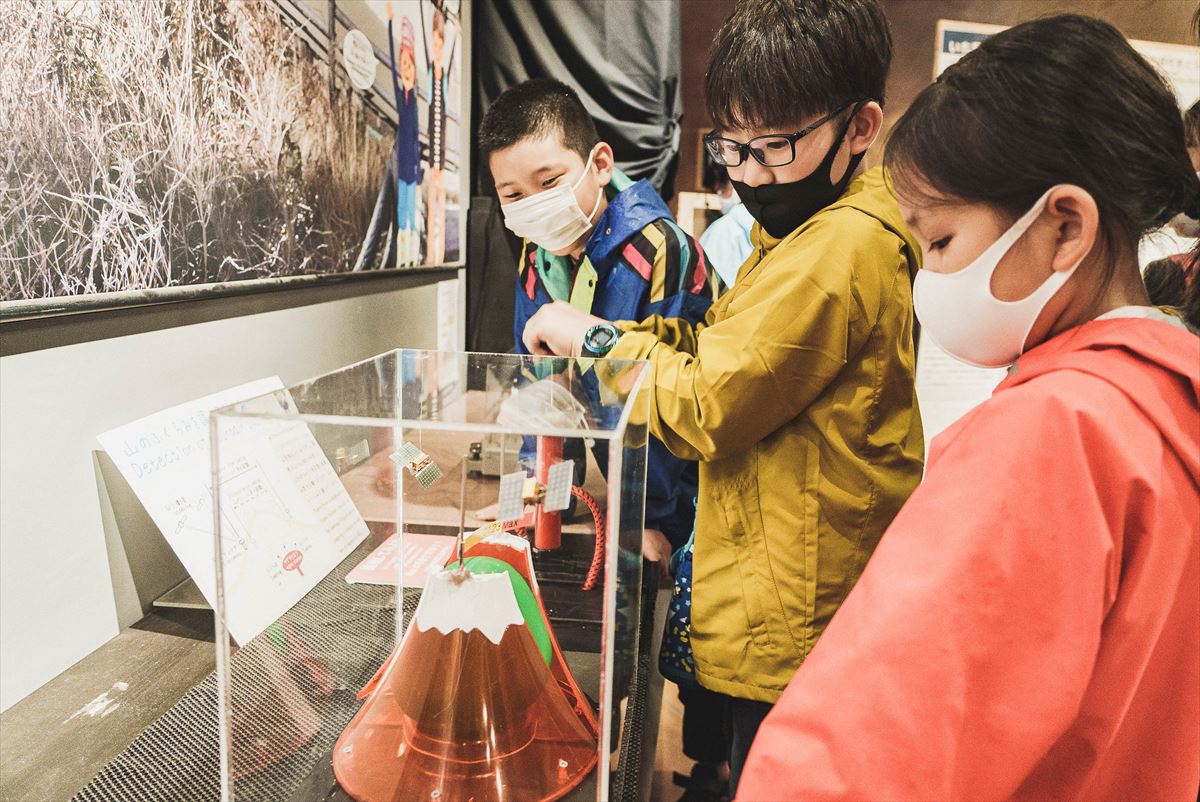
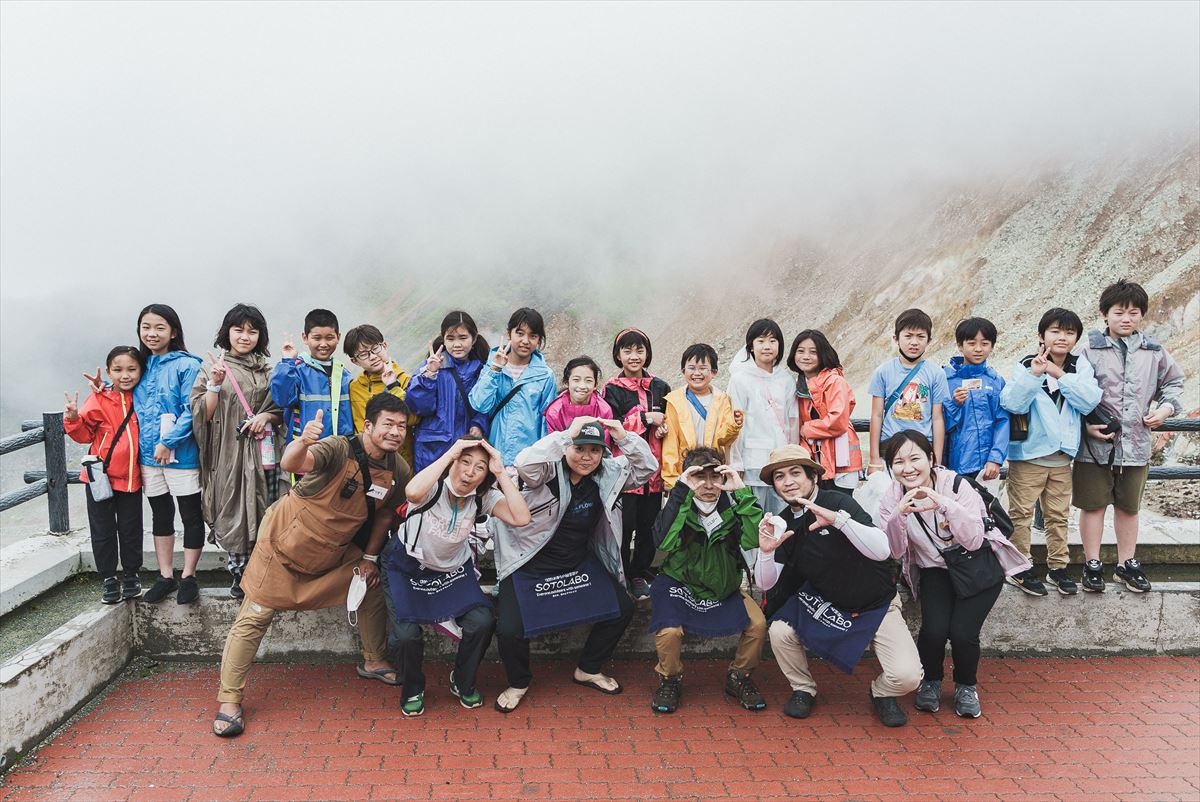
The stormy three days passed in the blink of an eye. Except for the first day, most scheduled programs had to be canceled due to rain. However, left with more time to spare, the children seemed to have grown closer to each other. Shinji Minakata of SOTOLABO, the leader of this year’s camp, reflected on the experience. “I am sure that the unexpected rain, especially the heavy rain on the first day we stayed in tents, contributed to the sense of unity. Happenings are a part of camping, but it is our job to manage the risks so that they do not become bad memories and to keep the campers in a positive frame of mind.”
He laughs and takes a sigh of relief. Miki Watanabe of the Hakone DMO was regretful that it rained. “However, I was happy to see that the children found ways to enjoy the rain,” she reflected. “And if they realize why it rains so much in Hakone, it will be a great community learning experience. Of course, I hope it will be sunny next time!”
GOLDWIN’s Mitsuhiro Fujimura recalls how moved he was on the second day’s morning. “The rain on the first day must have been tough on the children. It was a joy to see that they were still in good spirits, and the smiles on their faces that morning showed enormous resilience. It was a true relief to see that.”
Some of the children asked if they could bring their younger brothers next year or if they could participate even after graduating from primary school.
Mitsuhiro continued. “We were able to achieve our goal of making friends, but unfortunately, we could not experience nature as much as planned. While working with our learnings from this event, we would like to continue this camp program in the future.”
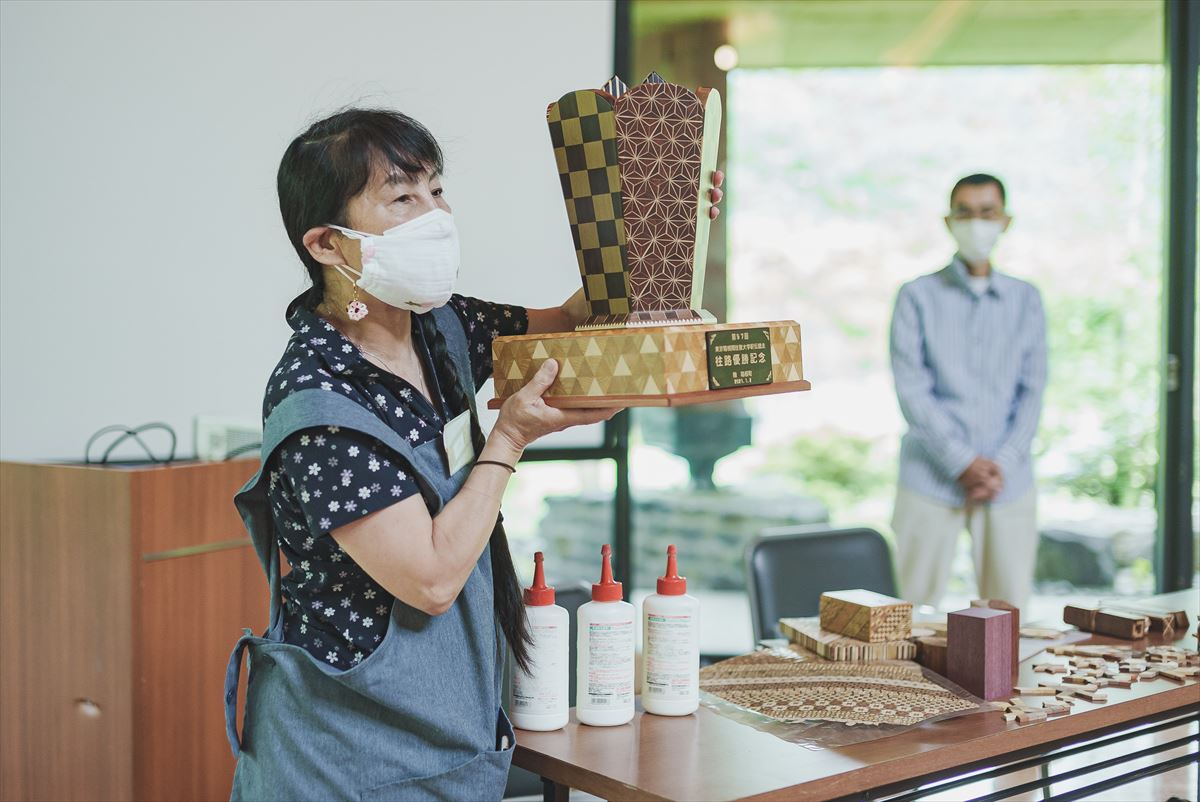
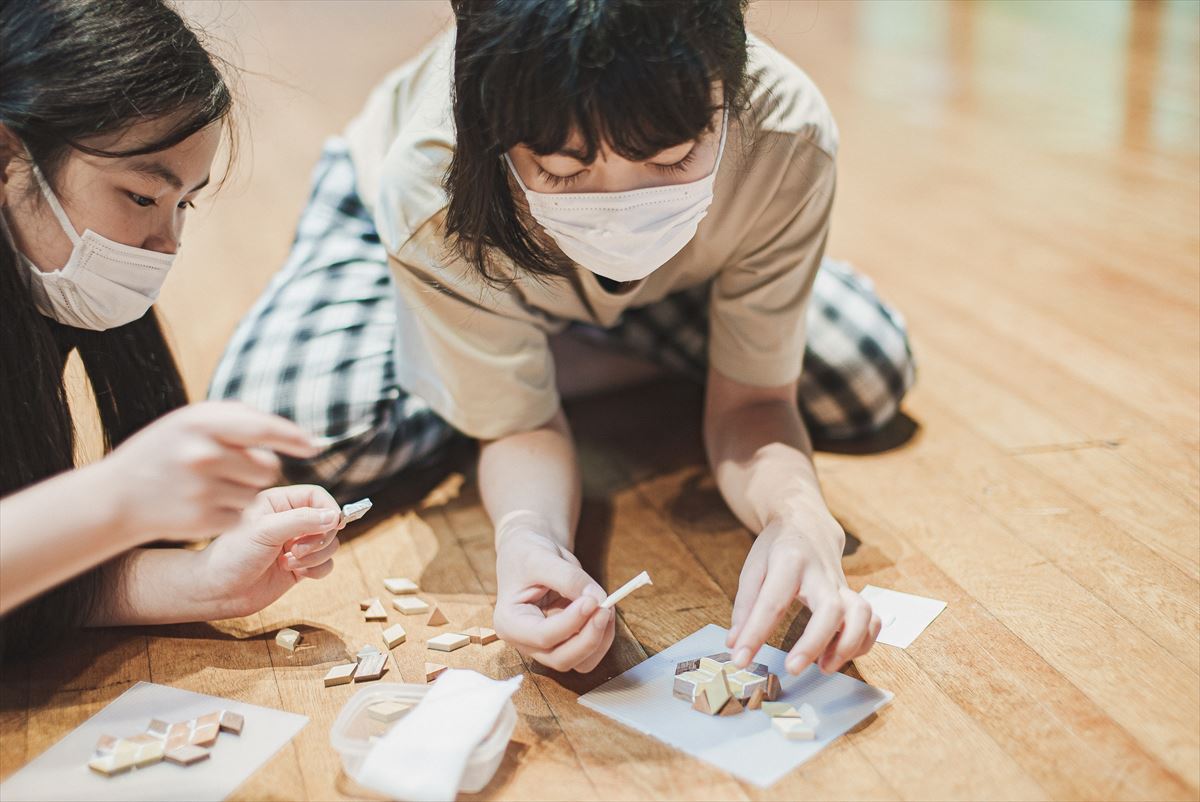
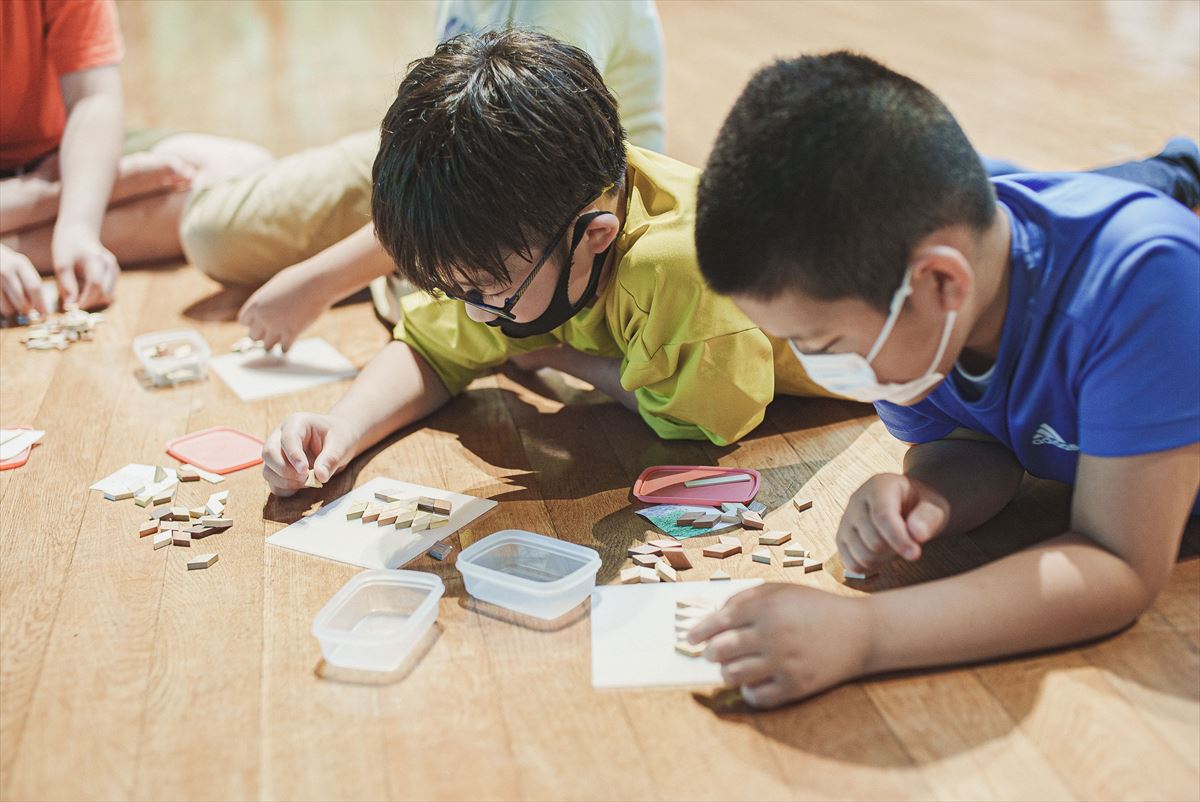
Nature exists without making allowance for us. The trees do not speak to us, and the sky rains and shines without concern for us. As we continue our journey of facing nature, we will gradually understand the distance between us. Daily life is comfortable as if cut off from nature’s fury, but here in nature itself, one must be flexible, agile, and adapt to nature with skill and spirit. Despite all this, nature sometimes smiles at us, and we can experience moments when we feel as if we are in harmony with the forest. This is why we want our children to experience nature.
Gota Miura explained to us the root of this feeling. “I believe that exposure to nature is an opportunity for children to return to their wild nature. The child’s dormant abilities are awakened when they come into contact with nature.”
School is a place to study and learn in a social dynamic. At our camp, we aim to offer an occasion of freedom. Spending time in a place where children are left to be children and meeting those of a similar age in such environment is significant when forming friendships. And, if there were staff specialized in outdoor activity and an adventurer in the mix, how great would that be?
The three days by the lake, in the rain, with the children left me in awe of their dazzling energy.

Text=Koki Aso
Photo = Masaya Kudaka
Translation = Asaka Barsley
Direction = Shin Kaneko
Interview support = Hakone Town, GOLDWIN, SOTOLABO



